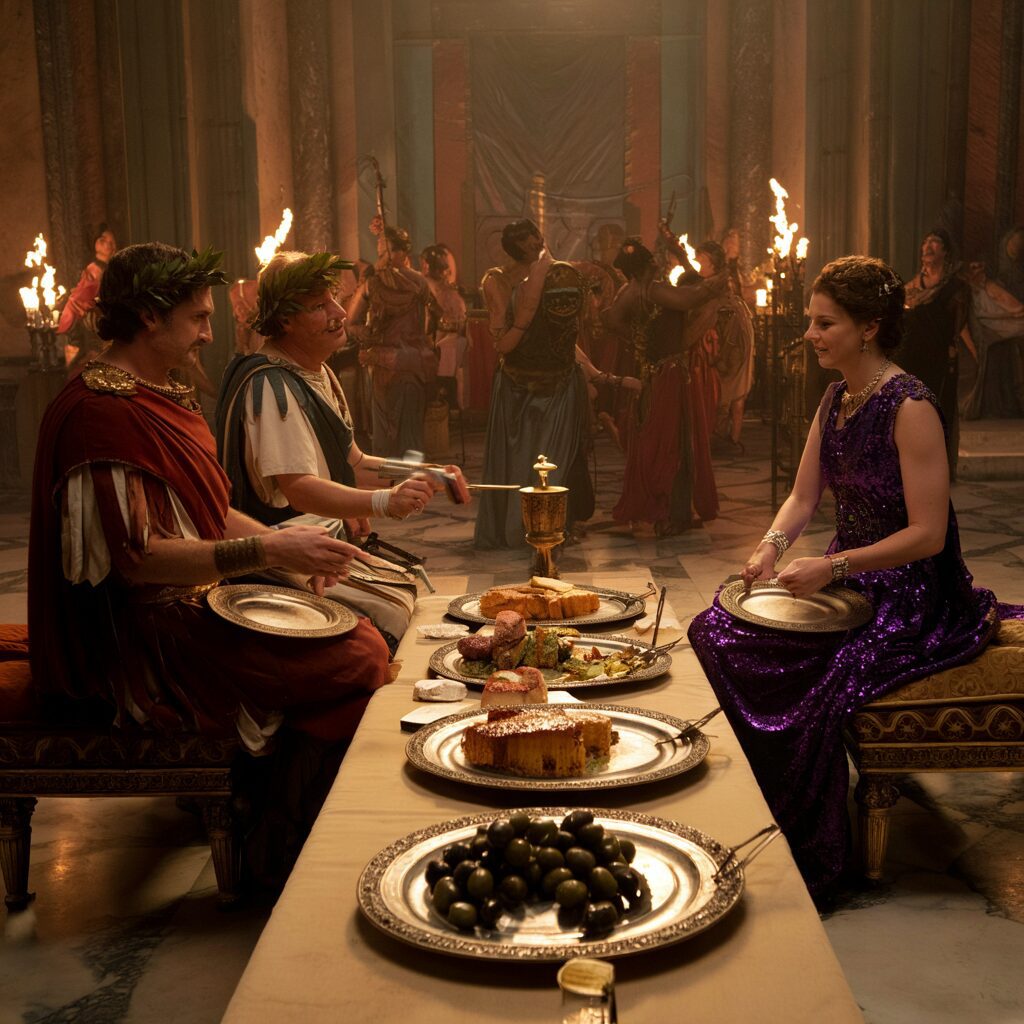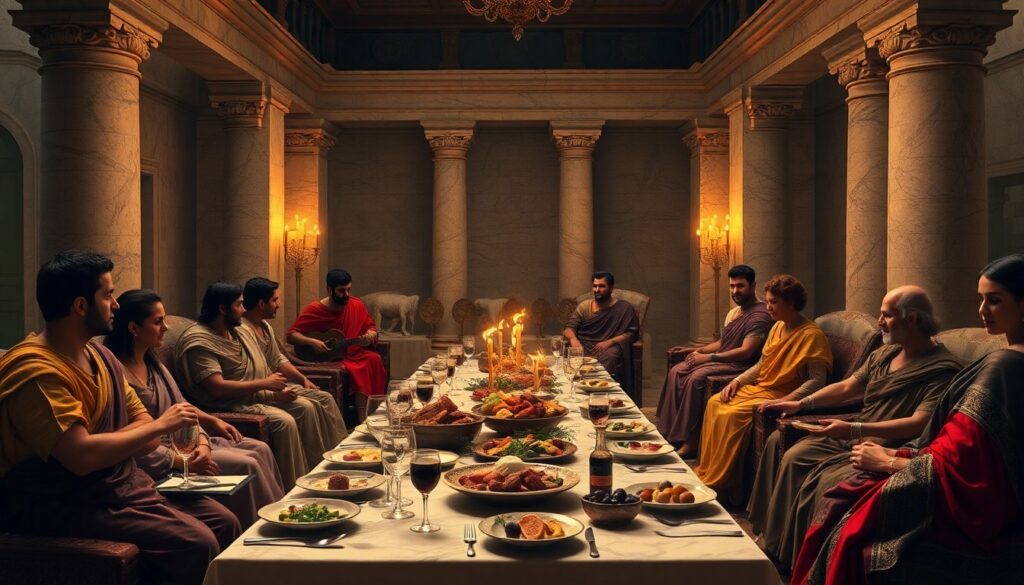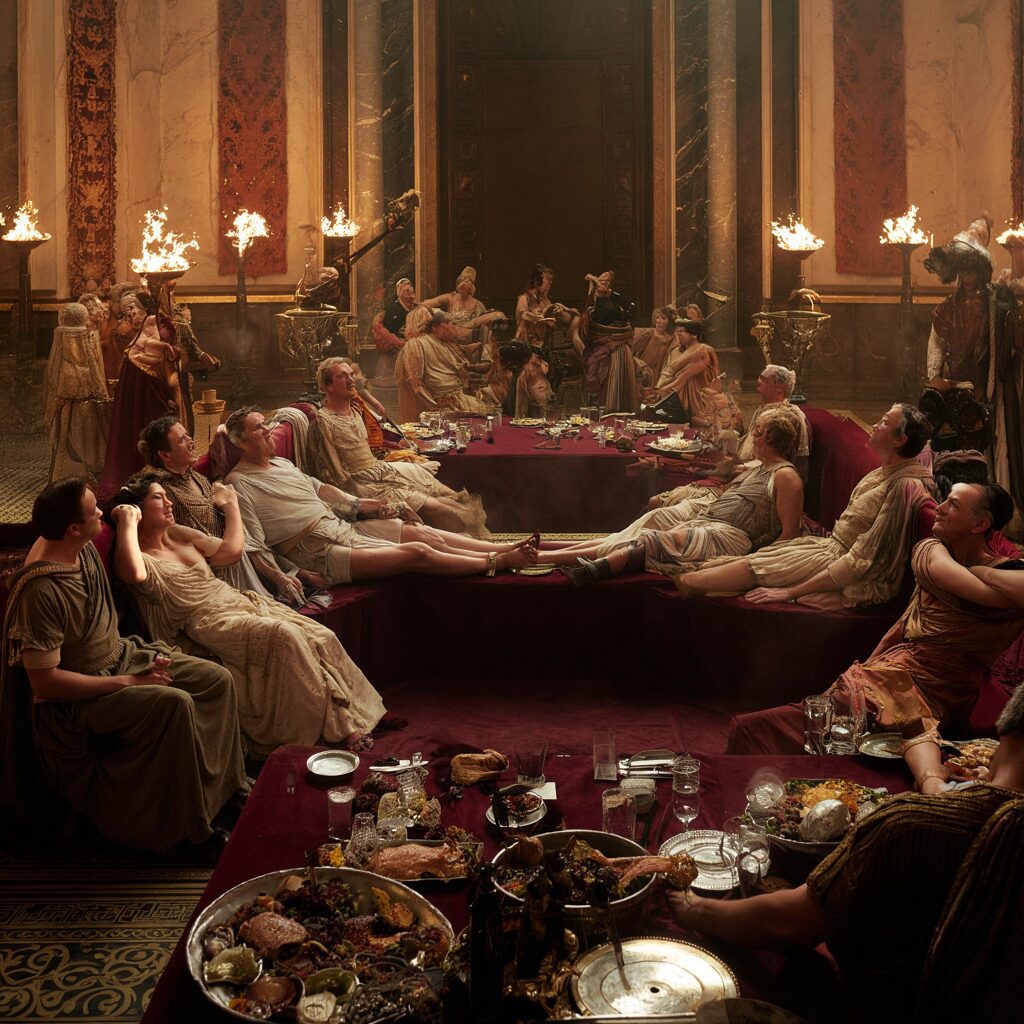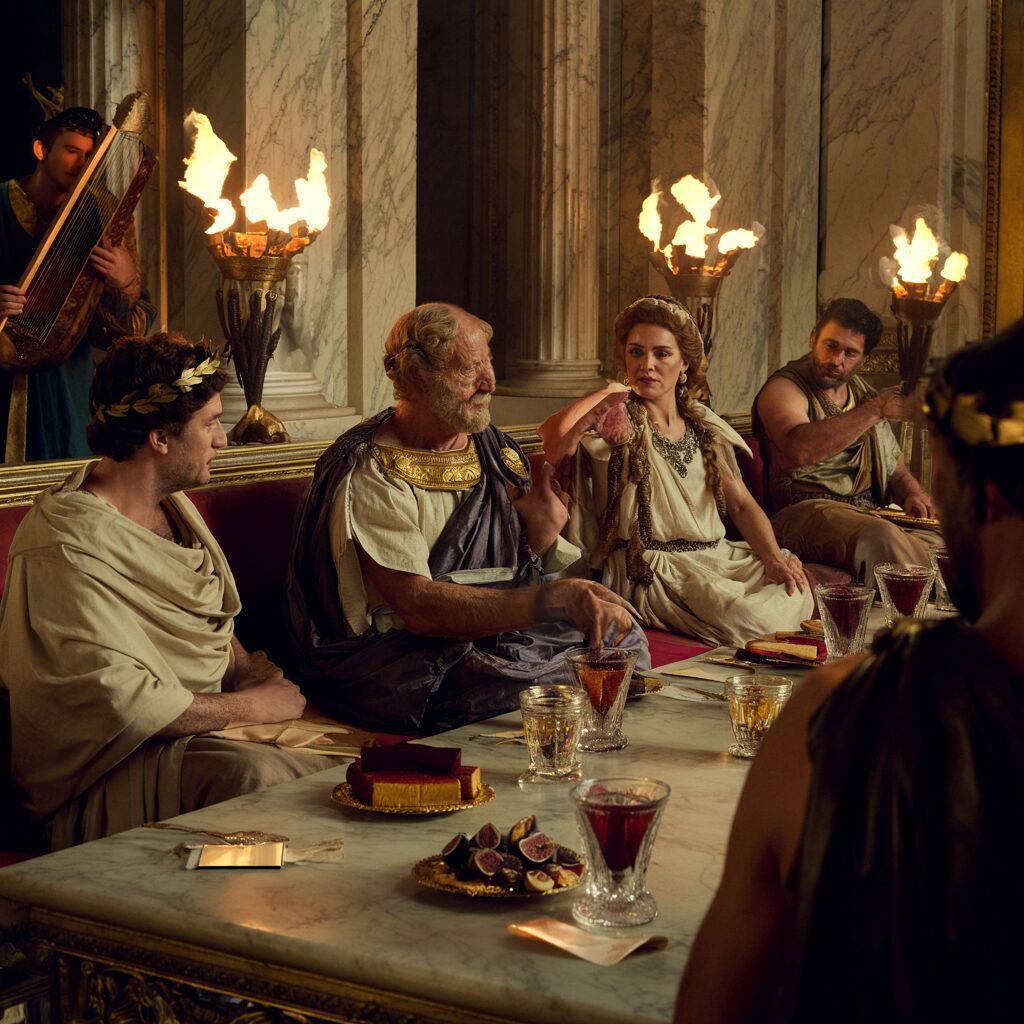Roman banquets, known as the convivium, were more than just meals; they were essential social rituals that reinforced status and cemented alliances among the elite. Held in a triclinium—a formal dining room arranged with three couches—these gatherings followed a strict seating arrangement reflecting social rank. Guests reclined while dining, engaging in conversation and displaying their wealth and refinement.
Dining with Emperors: The Etiquette and Rituals of Roman Banquets reveals how these events functioned as stages for power, culture, and influence. Understanding the detailed etiquette and rituals involved offers insight into the complex social dynamics of ancient Rome. These banquets symbolized cultural values such as hospitality, hierarchy, and sophistication, shedding light on how Romans navigated relationships in their society through shared meals.
Exploring the convivium uncovers layers of meaning behind every gesture—from seating to service—illuminating the grandeur and formality that defined elite Roman life.
The Structure of a Roman Banquet
Roman banquets, known as cena, underwent significant changes during the Imperial period, evolving in timing and complexity. Early Roman dinners were typically served around midday. Over time, the cena shifted to late afternoon or early evening, aligning with social customs that allowed for extended leisure and conversation.
The meal was divided into three distinct courses, each with a specific function and style:
1. Gustatio
The appetizer course. This stage featured light dishes such as eggs, olives, salads, and small fish. It was often accompanied by mulsum, a sweet wine mixed with honey. The gustatio set the tone for the banquet, stimulating guests’ appetites while inviting social interaction.
2. Prima Mensa
The main course. This was the heart of the banquet where roasted meats like pork, lamb, duck, or boar were served alongside vegetables and rich sauces flavored with garum—a fermented fish sauce that was a staple seasoning. Dishes could be elaborate stews or simply grilled preparations depending on the host’s wealth and tastes.
3. Secunda Mensa
The dessert course. Fruits such as figs and grapes appeared here alongside nuts, honey cakes, and imported delicacies like dates or exotic spices from the East. Sweet wines accompanied this final course to round off the meal.
During the Imperial period, this structured three-course format became more pronounced and ritualized. Banquets could last several hours, allowing guests to savor each course slowly while engaging in entertainment and conversation. The progression from gustatio to secunda mensa reflected not only culinary preferences but also social order—each course provided opportunities to display hospitality, sophistication, and status through choice of dishes and their presentation.

Food, Drink, and Presentation at Roman Banquets
At Roman banquets, the culinary experience was a lavish affair that encompassed a variety of flavors and presentations. Here’s a closer look at the food, drink, and presentation elements that made these banquets a grand spectacle:
1. Appetizers in Gustatio
The gustatio, or appetizer course, was the opening act of the banquet. Guests indulged in light dishes such as olives, nuts, seafood, and eggs. This course was accompanied by mulsum, a sweet wine mixed with honey that set a delightful tone for the meal to come.
2. Main Course with Garum Sauce
The centerpiece of the Roman banquet was the prima mensa, featuring a tantalizing array of roasted meats like pork, duck, and boar, alongside flavorful stews of lamb or fish. These dishes were often seasoned with garum, a fermented fish sauce that added a unique umami flavor to the meal.
3. Dessert Delights
The secunda mensa or dessert course was a sweet finale to the meal. Guests savored fresh fruits like figs and dates, along with honey cakes and imported delicacies from distant lands. This course added a touch of luxury and indulgence to the dining experience.
4. Wine Etiquette
Wine flowed freely throughout the banquet, symbolizing conviviality and abundance. However, it was customary to dilute wine with water as consuming undiluted wine was considered uncouth. The presentation of wine in elegant vessels added an air of sophistication to the proceedings.
The meticulous attention to detail in food preparation, drink service, and table presentation elevated Roman banquets into sophisticated culinary spectacles that delighted the senses and reflected the opulence of Roman society.

Etiquette, Manners, and Entertainment at Roman Banquets
In the world of Roman banquets, etiquette and good manners were highly valued, reflecting self-control and breeding in the guests. Here are some key points to consider:
1. Importance of Good Manners
At Roman banquets, displaying proper etiquette was essential to show respect for the host and guests. Guests were expected to conduct themselves with grace, speaking politely and engaging in meaningful conversation.
2. Views on Drunkenness
While some hosts tolerated excessive drinking as a form of entertainment, drunkenness was generally frowned upon at Roman banquets. Maintaining composure and moderation in wine consumption was seen as a sign of refinement and self-discipline. This is reminiscent of Korean drinking etiquette, which similarly emphasizes moderation and respect during such social occasions.
3. Entertainment during Meals
Entertainment played a significant role in Roman banquets, enhancing the overall dining experience. Guests were treated to music performances, poetry recitations, acrobatics, and even theatrical shows to keep them engaged throughout the meal.
The atmosphere at these banquets was not only about indulging in lavish food but also about upholding social norms through impeccable manners and enjoying sophisticated entertainment. Dining at these grand events truly offered a glimpse into the refined world of emperors and aristocrats.

Social Dynamics, Inclusivity, and Lavishness of Roman Banquets
Roman banquets evolved to reflect shifting social norms, particularly regarding the presence of women at banquets. In earlier periods, women were generally excluded from these formal dinners. By the Imperial era, respectable women could recline alongside men, signaling a gradual inclusion in elite social circles. This change marked a subtle but important shift in gender roles within Roman society.
Banquets often became lavish affairs lasting for hours, emphasizing the host’s wealth and status. These gatherings were not just meals but prolonged spectacles filled with conversation, entertainment, and repeated courses. The length of these banquets allowed guests to fully engage with one another while enjoying a variety of carefully prepared dishes.
Hosts frequently featured exotic dishes to impress guests—flamingo tongues, dormice dipped in honey, and other rare delicacies imported from distant provinces. Serving such unusual fare was a display of affluence and sophistication. These extravagant choices underscored the importance of dining as a venue for demonstrating power and cultural refinement.
The interplay between social inclusivity and lavish presentation made Roman banquets unforgettable experiences that reinforced social hierarchies and personal prestige.

Symbolism, Power, and Sophistication in Roman Banquet Culture
Roman banquets served as grand stages where wealth, power, and social hierarchy were prominently displayed through meticulously planned spectacles. The opulence of these gatherings encompassed not only the culinary offerings but also the entire experience curated by the host.
1. Spectacles Demonstrating Wealth and Power
Hosts showcased their affluence through extravagant decorations, rare imported ingredients, and sumptuous tableware crafted from silver, bronze, and fine glass. To astonish guests, exotic animals might be presented live or incorporated into dishes. Performances by musicians, dancers, and actors added an air of prestige. Some banquets even featured theatrical reenactments or elaborate displays such as fountains of wine or mechanical devices that left attendees in awe. Such lavishness was a direct proclamation of the host’s standing within Roman society.
2. Symbolism of Sophistication in Meal Presentation and Entertainment
The visual allure of meals conveyed refinement and cultural acumen. Dishes were artfully arranged with careful consideration given to color, texture, and aroma—an embodiment of a discerning palate. While adhering to tradition, the progression of courses also showcased the host’s expertise in culinary arts. Entertainment choices were thoughtfully curated to enhance the atmosphere—poetry recitations extolling virtues like bravery or wisdom reinforced ideals tied to Roman identity and elite values. Even seating arrangements served to emphasize social order, upholding respect for rank and decorum.
The banquet became a miniature representation of Roman power dynamics: every aspect from food to entertainment symbolized dominance, cultivated taste, and hierarchical relationships that shaped public life.
Conclusion
The elaborate etiquette and rituals of Roman banquets reveal much about Roman society—its values, hierarchies, and cultural sophistication. These gatherings were more than meals; they were performances of status and power, reflecting the host’s wealth and social influence.
Dining with Emperors: The Etiquette and Rituals of Roman Banquets offers insight into how food, manners, and entertainment intertwined to create lasting social bonds. Many elements from these ancient banquets resonate in modern dining practices:
- Formal seating arrangements that emphasize hierarchy
- Multi-course meals designed for sensory delight
- The balance of hospitality with subtle displays of prestige
The legacy of Roman banquet culture endures in the ways we celebrate special occasions, entertain guests, and use dining as a medium for connection and influence. Understanding this tradition enriches your appreciation of how ancient customs shape contemporary social rituals around the table.

